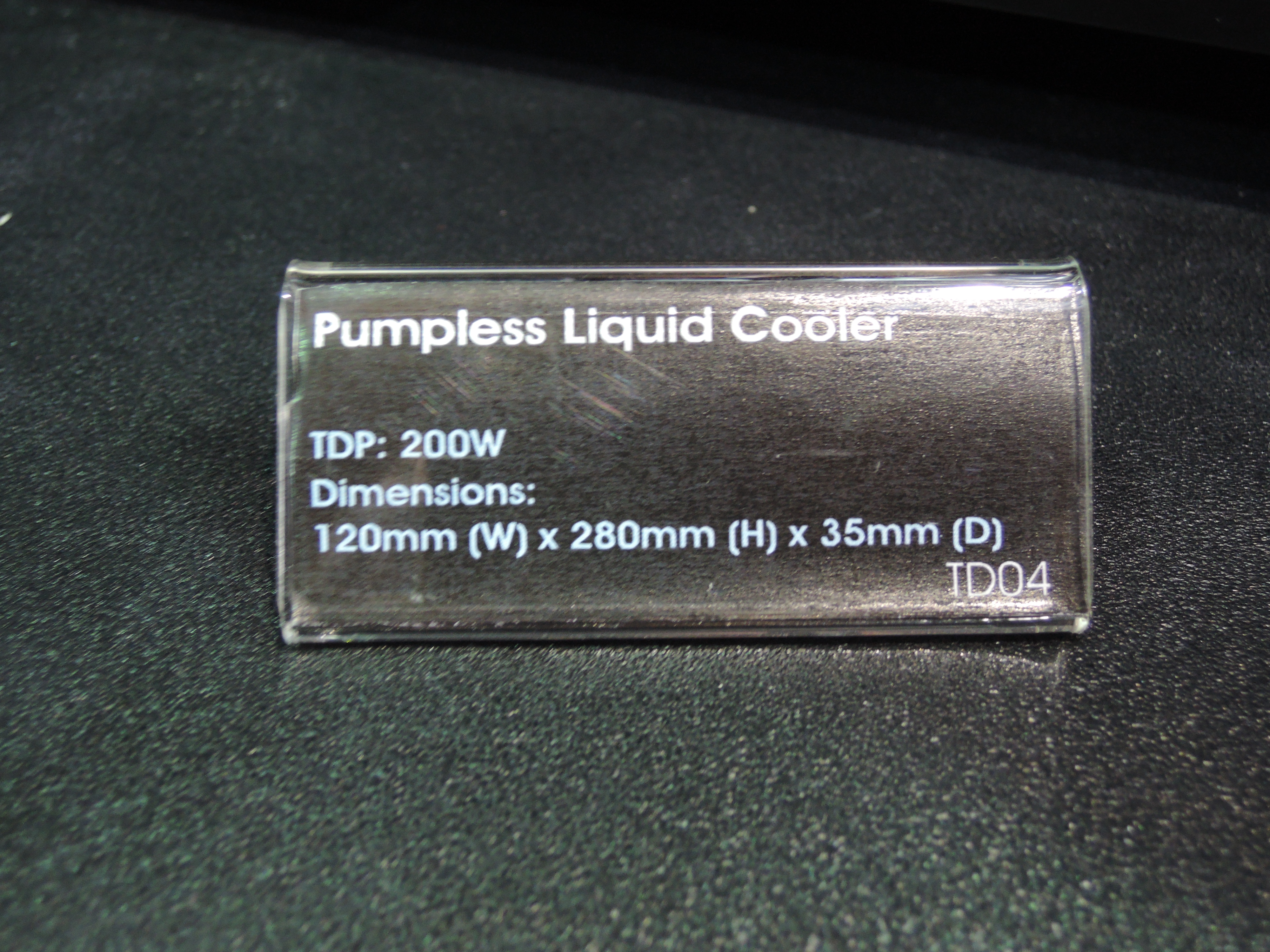SilverStone Reveals Pumpless Liquid Cooling System
SilverStone's new liquid cooler doesn't have a pump, yet the liquid still moves.
Editor's Note: While Computex took place last week and all of the news announcements are behind us, we're still sorting through hundreds of in-person meetings and demonstrations, picking out just a few more of the most interesting items we saw up close.
Water cooling has gained a lot of popularity recently, but one of the bigger problems people keep running into is water pumps that break. If that's not an issue, cheaper water pumps are also often quite noisy, defeating the purpose of cooling your system with water.
SilverStone showed its new TD04 pumpless liquid cooler at Computex 2014. This unit is a 240 mm water cooling unit that plainly doesn't have a pump. The only parts include the water block, clear tubing, radiator, and the fans. The unit is filled not with water, but with a liquid with a very low evaporation point. As a result, it feels cool to the touch, yet the water keeps bubbling inside the loop, which looks quite magical. SilverStone won't reveal what liquid the unit is filled with.
Cooling power is not one of the TD04's strong points though, as it is rated at a maximum TDP of 200 W. The idea behind this cooler is not to break new ground with cooling power, but rather to create a system that is pretty much perfectly silent, assuming you use the right fans, of course.
Hopefully, we'll know more about this product as time goes by. We'd really love to test something like this to see if it is a viable option for long-term use. Do note that the unit is still a prototype, so it might never actually reach the market.
Follow Niels Broekhuijsen @NBroekhuijsen. Follow us @tomshardware, on Facebook and on Google+.
Get Tom's Hardware's best news and in-depth reviews, straight to your inbox.
Niels Broekhuijsen is a Contributing Writer for Tom's Hardware US. He reviews cases, water cooling and pc builds.
-
firefoxx04 This is a really cool idea and im sure it works similar to a Block Heater for a car engine / diesel engine.Reply
The hot fluid rises and forces the colder fluid down. You can break the laws of physics, should be pretty reliable as long as the fluid moves quickly (perhaps the hotter it gets the faster it moves as well).
-
mortsmi7 Well, it's not exactly a new concept. Standard tower heatsinks already use this principle, as do many industrial water loops designed to maintain cooling in the event of a power outage.Reply -
sephirothmk They aren't revealing what type of liquid they are using. What if it's something quite toxic?Reply -
dstarr3 Isn't this how lava lamps work? The fluid nearer the heating element at the bottom becomes less dense, thus rises to the top, at which point it cools and becomes dense again, sinks to the bottom near the heating element again, repeat, etc?Reply
Would be pretty awesome to have a computer cooled by a lava lamp, must be said. -
soccerplayer88 ReplyThey aren't revealing what type of liquid they are using. What if it's something quite toxic?
I think it may have more to do with other companies trying to replicate what SilverStone has done. ; )
Now what IS interesting is that this technology has been around for awhile, but not in a closed loop like they are showing (at least I haven't seen it). In an open loop, you can simply use evaporation to move the liquid and generally your heat source (or your block) would need to be higher then the radiator. But like firefoxx04 said, they might be using the same principle as a Block Heater although in reverse as that concept attempts to keep the engine warmer in a colder environment.
Can't wait to see some testing done. -
vmem well, once it's open, I'm sure someone will buy one, cut open the tubing, and run it through some kind of chemical analysis system...Reply
chances are it's 70% ethanol or something. which would make sense since ethanol has a MUCH lower specific heat than water -
danwat1234 @Dstarr3 Yeah seems like the same physics as lava lamps and @firefoxx04 car engines, the hot coolant comes out the top side of the engine to the top of the radiator. Water goes out from the bottom of the radiator into the engine block (thermostat is on hot side I think). Cars have a water pump to force the flow.Reply
Ford's Ecoboost turbocharging system doesn't need idling before shutting off because the coolant flows through the system without a pump too.
Heatpipe technology can fluid (coolant?) in it that flows with the same concept. -
DavidRitchey This is a really good idea.Reply
I'm rather curious what thermal currents could do in a normal system using water, where the cooling tower is positioned higher in elevation, with the inlet on the low portion of the radiator and the return line on the higher portion of the radiator. Like the positioning of a passive solar water heating system.
And...why isn't this product on the market yet? -
alextheblue ReplyFord's Ecoboost turbocharging system doesn't need idling before shutting off because the coolant flows through the system without a pump too.
I'd have guessed they just ran the cooling fans off battery power for a short while. That's what a lot of aftermarket turbo'd vehicles are reprogrammed to do. -
sykozis Ford uses an electric water pump.Reply
A "block heater" on a car, is nothing but a heating element that's inserted into the block. This idea is completely different.
@Danwat1234 - Thermostat is usually on the outlet ("hot" side), but doesn't have to be. There are designs where the thermostat is placed in the inlet ("cold" side).


